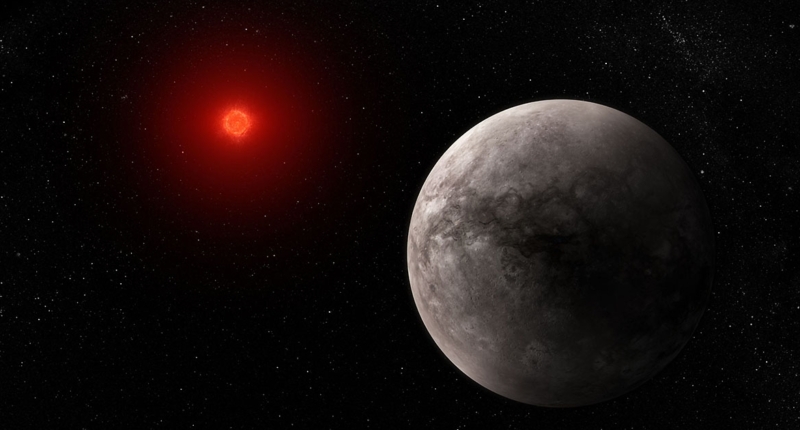NASA’s James Webb Space Telescope has made a groundbreaking discovery, detecting the thermal emission from a small, rocky exoplanet in the habitable zone of its star, TRAPPIST-1b. Using the Mid-Infrared Instrument (MIRI), the team of astronomers detected a change in brightness as the planet moved behind the star, enabling the measurement of the planet’s temperature. These observations have narrowed the possibility of the planet having an atmosphere that could redistribute heat, as the data suggests it is a bare, rocky planet. The discovery is crucial in further understanding the habitability of exoplanets in the TRAPPIST-1 system and smaller, cooler stars. Webb is set to capture further data on TRAPPIST-1b with hopes of capturing a full phase curve to confirm if the planet has an atmosphere. The James Webb Space Telescope is the world’s leading space science observatory, set to probe the mysterious structures and origins of our universe and our place in it.
NASA’s James Webb Space Telescope Measures Temperature of Rocky Exoplanet
NASA’s James Webb Space Telescope has been used by an international team of researchers to measure the temperature of a rocky exoplanet. The planet, known as TRAPPIST-1 b, is slightly larger than Earth and has a rocky composition. The temperature of the planet’s dayside was measured to be approximately 500 kelvins (roughly 450 degrees Fahrenheit) using mid-infrared light emitted by the planet. The results suggest that the planet does not have any significant atmosphere.
Illustration of TRAPPIST-1 b
An illustration based on data gathered by Webb’s Mid-Infrared Instrument (MIRI) and previous observations from other telescopes shows what TRAPPIST-1 b could look like. TRAPPIST-1 b is the innermost of seven planets in the TRAPPIST-1 system, orbiting its star at a distance of 0.011 AU and completing one circuit in just 1.51 Earth-days. The star, TRAPPIST-1, is an ultracool red dwarf (M dwarf) with a temperature of only 2,566 kelvins and a mass just 0.09 times the mass of the Sun.
The First Detection of Light Emitted by an Exoplanet
This is the first detection of any form of light emitted by an exoplanet as small and cool as the rocky planets in our own solar system. The result is a significant step in determining whether planets orbiting small active stars like TRAPPIST-1 can sustain atmospheres that support life. The study published in the journal Nature was led by Thomas Greene, an astrophysicist at NASA’s Ames Research Center. The result also shows Webb’s capability to characterize temperate, Earth-sized exoplanets using MIRI.
Rocky Planets Orbiting Ultracool Red Dwarfs
The findings are significant because TRAPPIST-1 b is one of the rocky planets orbiting ultracool red dwarfs, which are the most common stars in the Milky Way galaxy. The results suggest that more observations of rocky exoplanets are needed to understand their compositions and atmospheres, which could help in the search for life beyond our solar system. Webb’s mid-infrared capability allowed for the sensitivity to measure dim mid-infrared light, which no previous telescopes had.
NASA’s James Webb Space Telescope Measures Temperature of Rocky Exoplanet
NASA’s James Webb Space Telescope has measured the dayside temperature of TRAPPIST-1 b, an exoplanet that orbits an ultracool red dwarf star, 40 light-years away from Earth. The planet is the innermost of the seven rocky planets in the TRAPPIST-1 system, and slightly larger than Earth with a rocky composition. An international team of researchers measured the temperature of the planet’s dayside to be around 500 kelvins (roughly 450 degrees Fahrenheit) using mid-infrared light emitted by the planet.
Comparison to Computer Models
Computer models were used to compare the dayside temperature of TRAPPIST-1 b to what it would be under various conditions. The models took into account known properties of the system, including the temperature of the star and the planet’s orbital distance. The temperature of the dayside of Mercury was also included for reference. The models showed that if the heat energy from the star were distributed evenly around the planet, the temperature at 15 microns would be 400 kelvins (260 degrees Fahrenheit). If the atmosphere had a substantial amount of carbon dioxide, it would emit even less 15-micron light and would appear to be even cooler.
Tidal Locking and No Atmosphere
The result of the measurement suggests that TRAPPIST-1 b does not have any significant atmosphere. This is consistent with the temperature assuming the planet is tidally locked, with one side facing the star at all times, with a dark-colored surface, and no redistribution of heat from the dayside to the nightside. Although TRAPPIST-1 b is hot by Earth standards, it is cooler than the dayside of Mercury, which consists of bare rock and no significant atmosphere. Mercury receives about 1.6 times more energy from the Sun than TRAPPIST-1 b does from its star.
Implications for M-dwarf Systems
The discovery of TRAPPIST-1 b and the six other rocky planets orbiting the ultracool red dwarf star is significant as they are similar in size and mass to the inner, rocky planets of our own solar system. Although they orbit much closer to their star than any of our planets, they receive comparable amounts of energy. There are ten times as many M-dwarf stars in the Milky Way than there are stars like the Sun and they are twice as likely to have rocky planets. However, they are also very active and give off flares and X-rays that can wipe out an atmosphere.
Conclusion
The discovery of TRAPPIST-1 b and its sibling planets can provide important information about M-dwarf systems and rocky exoplanets in general. Webb’s measurement of mid-infrared light given off by TRAPPIST-1 b suggests that the planet does not have any substantial atmosphere, which is a significant step in determining whether planets orbiting small active stars like TRAPPIST-1 can sustain atmospheres needed to support life. The result also shows Webb’s capability to characterize temperate, Earth-sized exoplanets using MIRI.
TRAPPIST-1 System: A Great Laboratory for Studying Terrestrial Planets
The TRAPPIST-1 system, which consists of seven rocky planets orbiting an ultracool red dwarf star, is a great laboratory for understanding habitability around M stars. The planets are similar in size and mass to the inner, rocky planets of our solar system, but orbit much closer to their star, receiving comparable amounts of energy. Webb’s measurement of mid-infrared light given off by TRAPPIST-1 b suggests that the planet does not have any substantial atmosphere, which is a significant step in determining whether planets orbiting small active stars like TRAPPIST-1 can sustain atmospheres needed to support life.
Detecting an Atmosphere (or Not)
Astronomers used Webb’s Mid-Infrared Instrument (MIRI) to measure the brightness of mid-infrared light emitted by TRAPPIST-1 b. The planet is tidally locked, with one side facing the star at all times, and the other in permanent darkness. The change in brightness of the TRAPPIST-1 system as the innermost planet moves behind the star is known as a secondary eclipse. The brightness of the star is subtracted from the combined brightness of the star and planet to calculate how much infrared light is coming from the planet’s dayside. This is then used to calculate the dayside temperature. The observations show that the planet’s dayside temperature is around 500 kelvins (roughly 450 degrees Fahrenheit), consistent with the temperature assuming the planet has no substantial atmosphere.
A Great Laboratory for Studying Terrestrial Planets
Co-author Elsa Ducrot from the French Alternative Energies and Atomic Energy Commission (CEA) in France, who was on the team that conducted earlier studies of the TRAPPIST-1 system, emphasized that the system is a great laboratory for studying terrestrial planets. M-dwarf stars, like TRAPPIST-1, are easier to characterize for terrestrial planets because they are smaller and cooler than stars like the Sun. They are also twice as likely to have rocky planets. However, they are also very active and give off flares and X-rays that can wipe out an atmosphere.
Comparing Observations
Previous observations of TRAPPIST-1 b with the Hubble and Spitzer space telescopes found no evidence for a puffy atmosphere, but were not able to rule out a dense one. The observations using Webb’s MIRI suggest that the planet does not have any significant atmosphere. The observations are being repeated using a 12.8-micron filter in order to confirm the results and narrow down the interpretations.
Conclusion
The TRAPPIST-1 system is an important target for astronomers as it can provide valuable insights into the habitability of planets orbiting small active stars like TRAPPIST-1. The observations using Webb’s MIRI have shown that TRAPPIST-1 b does not have any significant atmosphere, which is a significant step in determining whether planets orbiting small active stars can sustain the atmospheres needed to support life.
The TRAPPIST-1 system has been studied in depth by astronomers and scientists, with the innermost planet, TRAPPIST-1 b, being the focus of much attention. By using the Webb telescope’s Mid-Infrared Instrument (MIRI), the team was able to calculate the amount of infrared light given off by TRAPPIST-1 b. This was done by subtracting the brightness of the star alone from the combined brightness of the planet and star during secondary eclipse photometry.
Webb’s ability to detect such a small change in brightness was a major achievement, as the change is less than 0.1%. However, the team was able to accurately calculate the temperature of the planet’s dayside. They compared their results to computer models to show that the temperature was consistent with a blackbody made of bare rock with no atmosphere to circulate heat.
This research was conducted as part of Webb’s Guaranteed Time Observation (GTO) program, which is one of eight programs from Webb’s first year of science designed to help fully characterize the TRAPPIST-1 system. Additional observations of TRAPPIST-1 b are currently underway, and the team hopes to eventually capture a full phase curve to confirm whether the planet has an atmosphere or not.
Co-author Elsa Ducrot from the French Alternative Energies and Atomic Energy Commission (CEA) in France explains that studying planets around smaller, cooler stars, such as M dwarfs, is easier and the TRAPPIST-1 system is a great laboratory for this research. The observations of TRAPPIST-1 b provide important information for scientists studying the atmospheres of rocky planets.
The team’s research is helping scientists understand the habitability of M dwarf systems, which have ten times more stars than our own Milky Way and are twice as likely to have rocky planets as stars like the Sun. Although these stars are very active and give off flares and X-rays that can wipe out an atmosphere, they are a valuable target for scientific research.
The team behind NASA’s James Webb Space Telescope has achieved a major milestone in discovering exoplanets. The team was able to detect the emission from a rocky, temperate planet using a technique called secondary eclipse photometry, which allowed them to measure the change in brightness as the planet moved behind its star. This was the first time that Webb was able to detect the thermal emission of a rocky planet that is as small as Earth and as cool as the rocky planets in our solar system. Webb is a joint project of NASA, the European Space Agency (ESA), and the Canadian Space Agency (CSA). The Mid-Infrared Instrument (MIRI) used for the observation was designed and built by a consortium of nationally funded European Institutes and NASA’s Jet Propulsion Laboratory.
Don’t miss interesting posts on Famousbio










